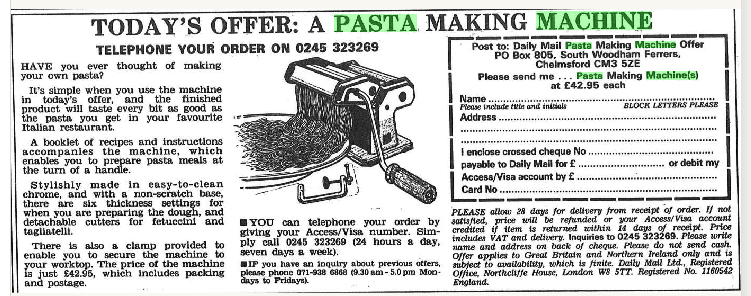Written by Jess Edwards and Daniel Pullin
Daniel and I are both keen on History – and food! The events currently taking place throughout the UK to celebrate British Food Fortnight led us to consider what actually constitutes ‘British Food’. Of course, in one sense the phrase describes food produced in Britain, but it could also mean the food eaten most regularly in the UK, and entrenched in British culture, which equates to a very different interpretation of ‘British Food’. Many of the meals most commonly eaten in Britain today have been introduced from foreign shores. We decided to explore the development of the modern British palate in the Gale archives, and unearthed historical references to both foreign and native recipes – as well as learning how both have solidified their reputation and popularity in British food culture. And to add an amusing twist, we thought we’d rustle up a few dishes under the guidance of these historical recipes…!
![Lady Charlotte, "An Indian Recipe for Curry." Daily Mail [London, England] 23 June 1898, p.7. Daily Mail Historical Archive](http://blog.gale.cengage.co.uk/wp-content/uploads/2016/09/An-Indian-Recipe-for-Curry.png)
![Our attempt at the following recipe…. Lady Charlotte, "An Indian Recipe for Curry." Daily Mail [London, England] 23 June 1898, p.7. Daily Mail Historical Archive](http://blog.gale.cengage.co.uk/wp-content/uploads/2016/09/DSC02375-1024x577.jpg)
Lady Charlotte, “An Indian Recipe for Curry.” Daily Mail [London, England] 23 June 1898, p.7. Daily Mail Historical Archive!["A la Carte Spaghetti" Sunday Times [London, England] 25 Oct. 1964: 50[S]. The Sunday Times Digital Archive, 1822-2006](http://blog.gale.cengage.co.uk/wp-content/uploads/2016/09/How-to-dine-in-rome-at-home-screenshot.png)
Perhaps even more prominent in the British palate today is pasta. As we’re not content with frequently consuming home-boiled pasta, almost every British high street features an Italian restaurant to meet the British craving for Italian foodstuff. Though its initial infiltration into British culture would have occurred much earlier, we found in Gale Newsvault an increase in discussion of pasta dishes from about the 1920s. At that time, most articles still described pasta as a new contribution to the British palate; its various shapes are often defined and origin indicated.
Then, as now, one of the great appeals of pasta was its short preparation time, making it suitable for unregulated eating habits. In 1928 the Aberdeen Press and Journal said it was ‘excellent’ for when ‘guests arrive too late for dinner’, and you could even prepare it ‘in the middle of the night’ – how liberating![5] So while housewives were still rubbing their own pastry and kneading their own bread, pasta was already widely available ready-made; in 1949 the Daily Mail wrote ‘most English grocers sell spaghetti or macaroni in some form all ready for the boiling water.’[6] By 1958 The Times was describing the ‘miles of spaghetti’ consumed in London, and discussing increases in native production, suggesting pasta was entrenched in the British palate by the 1950s.[7] Mass native production is also evident in a 1964 advert in The Sunday Times for A La Carte Spaghetti exclaiming ‘How to dine in Rome at Home’![8]
!["Italy's Staple Dish." Aberdeen Press and Journal [Aberdeen, Scotland] 2 July 1928: 2. 19th Century British Newspapers](http://blog.gale.cengage.co.uk/wp-content/uploads/2016/09/Italys-staple-dish.png)

(Having been given one herself as a birthday present, Jess is included in this cultural phenomenon!) ‘From scratch’ recipes have appeared for ravioli throughout the decades, however; ‘We in this country do not often make pasta, except for ravioli’ wrote The Listener in 1950.[9] It is, perhaps foolishly, this riskier recipe that Daniel and I attempted – mainly for the chance to use the pasta machine!…
!["Today's Offer: A Pasta Making Machine." Daily Mail [London, England] 20 Sept. 1990: 46. Daily Mail Historical Archive, 1896-2004](http://blog.gale.cengage.co.uk/wp-content/uploads/2016/09/rolling-out-dough-using-a-past-making-machine.png)


[1] “Italy’s Staple Dish.” Aberdeen Press and Journal [Aberdeen, Scotland] 2 July 1928: 2. 19th Century British Newspapers
[2] “In Italy it’s the sauce that counts.” Daily Mail [London, England] 24 Sept. 1949: 4. Daily Mail Historical Archive, 1896-2004
[3] “Miles Of British Spaghetti.” Times [London, England] 14 June 1958: 4. The Times Digital Archive, 1785-2009
[4] “A la Carte Spagnetti” Sunday Times [London, England] 25 Oct. 1964: 50[S]. The Sunday Times Digital Archive, 1822-2006
[5] Helen Davies, “Recipes for the Housewife.” Listener 29 June 1950: 1115. The Listener Historical Archive 1929-1991
[6] “The Lady’s Assistant in the Whole Art of Cookery.” New Lady’s Magazine (1786): 244+. Nineteenth Century Collections Online
[7] Colonel Kenney-Herbert, From the Cookery Annual of 1895, “Curry-Making.” Everyday Housekeeping V.4 (1896): 176+. Nineteenth Century Collections Online.
[8] Ibid.
[9] Lady Charlotte, “An Indian Recipe for Curry.” Daily Mail [London, England] 23 June 1898, p.7. Daily Mail Historical Archive

